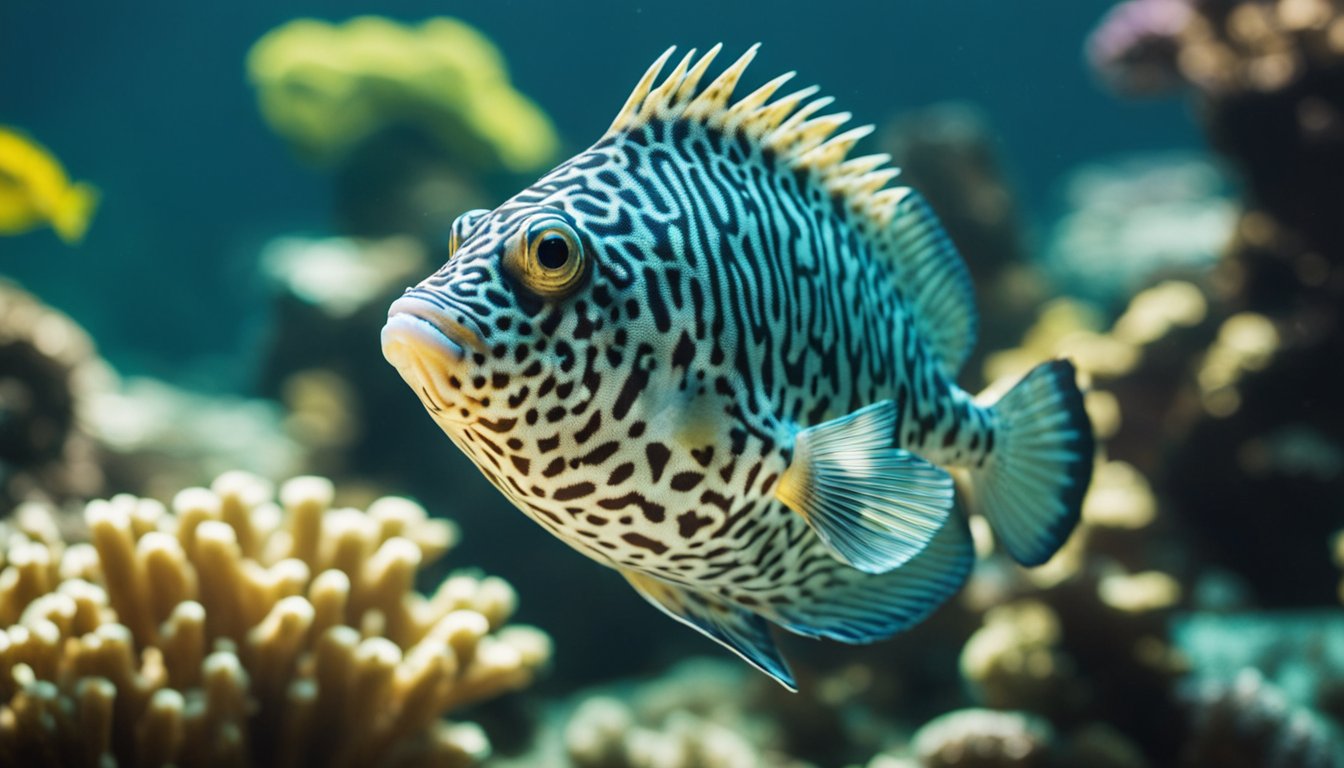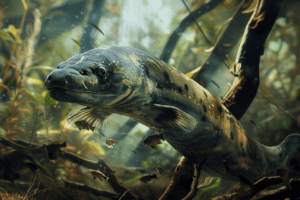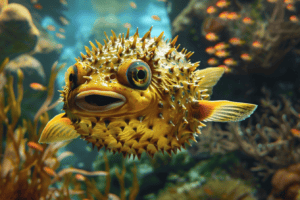The ocean is home to some of the most fascinating creatures on Earth, and the armor-plated box fish is no exception.
These unique fish are known for their hexagonal shape and hard, bony plates that cover their bodies.
They are found in tropical waters around the world and are a favorite among divers and snorkelers.

Knights of the Deep: The Armor-Plated Box Fish is an article that delves into the fascinating world of these fish.
Readers will learn about the box fish’s physical characteristics, behavior, and habitat.
They will also discover how these fish are able to survive in the harsh ocean environment, and the important role they play in the ecosystem.
Did you know that the armor-plated box fish is not a great swimmer?
Instead, it relies on its boxy shape and hard plates to protect itself from predators.
Its unique shape also allows it to wedge itself into small crevices and hide from danger.
These and other fun facts will be explored in this article, making it a must-read for anyone interested in marine life.
The Biology of the Box Fish

Box fish are unique creatures that belong to the family Ostraciidae.
They are known for their distinctive body shape and armor-plated protection that make them look like swimming boxes.
Let’s explore the biology of these fascinating fish and learn more about their unique characteristics.
Unique Body Shape
Box fish have a box-like shape that sets them apart from other fish species.
Their bodies are covered in hexagonal plates that fit together like a puzzle, forming a rigid exoskeleton that protects them from predators.
The plates are made of a bony material that is fused together, providing additional strength to the structure.
The box fish’s body shape is not just for protection, but also for efficient swimming.
Their triangular fins are positioned at the corners of their bodies, allowing them to move through the water with ease.
The fins act like rudders, providing stability and maneuverability in the water.
This unique body shape also helps them to conserve energy, making them efficient swimmers.
Armor-Plated Protection
Box fish are covered in armor plating that serves as a protective shield against predators.
The plates are made of a bony material that is fused together, providing additional strength to the structure.
The armor plating is so strong that it can even withstand the bites of sharks.
The armor plating also serves as a defense mechanism against parasites and other harmful organisms.
The hexagonal plates are covered in a layer of mucus that prevents parasites from attaching to the fish’s skin.
This adaptation helps to keep the box fish healthy and free from disease.
In addition to their armor plating, box fish also have a unique defense mechanism that involves releasing toxins when threatened.
The toxins are secreted from the skin and can be deadly to other fish. This adaptation helps to deter predators and keep the box fish safe.
Box fish are truly remarkable creatures that have adapted to survive in their underwater environment.
Their unique body shape and armor-plated protection make them one of the most fascinating fish species in the ocean.
Habitats and Behavior

Oceanic Homes
The armor-plated box fish is a unique and fascinating creature that can be found in the warm waters of the Pacific and Indian Oceans.
These fish are mainly found in coral reefs and lagoons, where they can hide from predators and find food.
They are also known to inhabit seagrass beds and sandy bottoms.
Box fish have a unique way of swimming, using their pectoral fins to move in a slow and deliberate manner.
They are not strong swimmers and prefer to glide along the ocean floor, using their box-like shape to their advantage.
Their hard, armor-plated exterior provides excellent protection from predators, and they can retreat into their box-like shape when threatened.
Social Dynamics
Box fish are solitary creatures and prefer to live alone.
They are not known to form schools or groups, but they do have a unique way of communicating with each other.
They use a series of grunts and clicks to communicate, which can be heard by other box fish in the area.
Box fish are also known for their unique mating behavior. When it is time to mate, the male will build a nest out of sand and debris on the ocean floor.
He will then entice the female to lay her eggs in the nest, which he will then fertilize.
The male will guard the nest until the eggs hatch, which can take several days.
In conclusion, the armor-plated box fish is a fascinating creature that is well adapted to life in the ocean.
Their unique shape and behavior make them a wonder to behold, and they are a testament to the amazing diversity of life in the ocean.
Conservation and Threats

Environmental Challenges
The armor-plated box fish, also known as the cowfish, is a unique and fascinating creature that faces several environmental challenges.
One of the primary threats to the box fish is the degradation of its natural habitat.
As a reef-dwelling species, the box fish relies on healthy coral reefs for food, shelter, and breeding grounds.
Unfortunately, coral reefs around the world are under threat due to climate change, ocean acidification, and pollution.
Another environmental challenge that the box fish faces is the depletion of its food sources.
As an omnivore, the box fish feeds on a variety of small invertebrates and algae.
However, overfishing and destructive fishing practices have led to a decline in the box fish’s prey species, which in turn affects the box fish’s survival.
Human Impact
In addition to environmental challenges, the armor-plated box fish is also impacted by human activities.
One of the most significant threats to the box fish is the aquarium trade.
The box fish’s unique appearance and behavior make it a popular choice for aquarium enthusiasts.
However, the capture and transportation of wild box fish for the aquarium trade can be harmful to the species, as it can lead to stress, injury, and death.
Another human impact on the box fish is pollution.
As a coastal species, the box fish is vulnerable to pollution from land-based sources such as runoff from agricultural and urban areas.
This pollution can lead to the degradation of the box fish’s habitat and can also affect the health of the box fish directly.
Overall, the armor-plated box fish faces several conservation challenges that require action from individuals, communities, and governments.
By protecting and restoring coral reefs, reducing pollution, and promoting sustainable fishing practices, we can help ensure the survival of this unique and important species.
Frequently Asked Questions

What unique features help the armor-plated box fish survive in its underwater habitat?
The armor-plated box fish is known for its unique and impressive features that allow it to survive in its underwater habitat.
One of the most notable features is its tough, armor-like skin that keeps it safe from predators.
The skin is made up of hard, bony plates that overlap, providing a strong and protective shield.
Additionally, the box fish has a small mouth and sharp teeth that it uses to feed on small invertebrates and crustaceans.
How does the box fish’s distinctive shape contribute to its way of life in the ocean?
The box fish’s distinctive shape is another key feature that contributes to its way of life in the ocean.
The boxy shape of the fish helps it to maneuver through the water with ease, and it also provides a stable base for the fish to rest on the ocean floor.
The box fish can also wedge itself into tight spaces, using its hard, bony plates to protect itself from predators.
In what ways do box fish interact with other creatures under the sea?
Box fish are known to interact with other creatures under the sea in a variety of ways.
They are often found living in small groups, and they use their sharp teeth to defend themselves and their territory.
They also feed on small invertebrates and crustaceans, which can have an impact on the ecosystem of coral reefs.
Additionally, box fish are often preyed upon by larger fish and sharks.
What can we learn from the box fish’s armor when designing human inventions?
The armor of the box fish is a remarkable example of natural engineering, and it has inspired scientists and engineers to study its unique properties.
The hard, bony plates of the box fish’s skin are incredibly strong and lightweight, making them ideal for use in a variety of human inventions.
Scientists are currently studying the box fish’s armor to develop new materials for use in protective gear, such as helmets and body armor.
How do box fish maintain buoyancy and maneuver through the water?
Box fish maintain buoyancy and maneuver through the water using a variety of techniques.
They have a swim bladder that helps them to control their buoyancy, allowing them to move up and down in the water column.
Additionally, they use their pectoral fins to move through the water, and they are able to change direction quickly by using their dorsal and anal fins.
What role does the diet of a box fish play in the ecosystem of coral reefs?
The diet of a box fish plays an important role in the ecosystem of coral reefs.
Box fish feed on small invertebrates and crustaceans, which helps to control the population of these animals.
This, in turn, can have a positive impact on the health of the coral reef ecosystem.
However, overfishing and other human activities can disrupt this delicate balance, leading to declines in box fish populations and potentially damaging the coral reef ecosystem.









